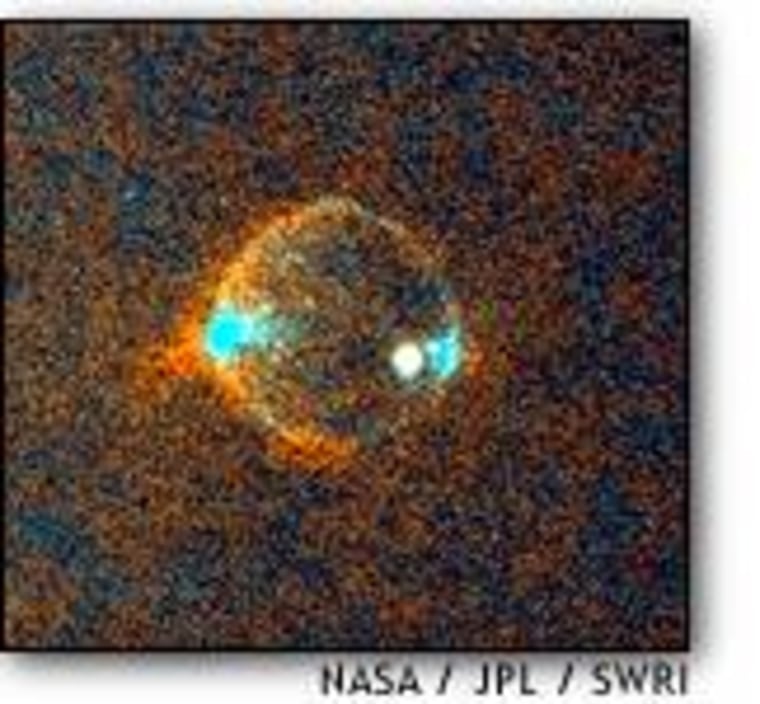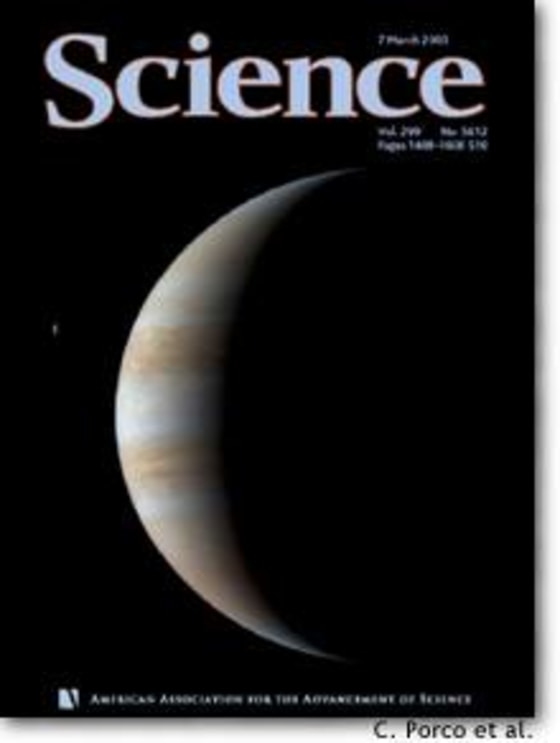When the Cassini spacecraft passed by Jupiter on its way to Saturn, its cameras took a good, long look at the giant planet. Now, after studying a select subset of the whopping 26,000 images taken over six months, researchers have new insights into everything from the weather on Jupiter to its outlying moons. The Cassini Imaging Team describes its findings in the journal Science, published by the American Association for the Advancement of Science.
First, some basics about the solar system’s largest planet. As one of the so-called gaseous planets, it doesn’t have a distinct surface, like Earth does. Instead, it’s swathed by many layers of clouds, where hydrogen, helium and other gases gradually become denser with depth. The planet does have some liquid layers deep within, and a nugget of rock at its core, but little is known about the planet’s interior.
Many of Jupiter’s other features are super-sized in scale (except for its rings, which are scrawny and diffuse, compared with Saturn’s). The Jovian magnetosphere, the bubble around the planet that deflects the charged particles streaming out from the sun, is the largest structure in the solar system. The planet also has at least 52 moons — the four large “Galilean satellites,” including the furiously volcanic Io, and dozens of smaller ones.
Cassini used Jupiter’s strong gravity to boost the spacecraft towards Saturn. In the process, the researchers took advantage of Cassini’s great view of Jupiter to test its sophisticated instruments, undergo a complete “dress rehearsal” in preparation for Saturn and gather new information about the Jovian neighborhood.
“It was an opportunity we could ill afford to pass up. … The leisurely pace of the flyby was a blessing,” said study author Carolyn Porco of the Southwest Research Institute.
The perfect storm?
Cassini passed Jupiter just at the right distance for the cameras to capture the entire planet, providing an unprecedented look at Jupiter’s weather.
“We took a very long series of images of the planet, giving scientists the opportunity to observe the character of atmospheric motions,” Porco said. “The eye is good at discerning moving patterns, so this was a very good way to recognize phenomena that would have been hard to pick out in still images.”
A storm on Jupiter is probably somewhat like one on Earth in many respects. It would include torrential rainfall, intense winds and possibly thunder and lightning. A major difference, however, is that Jovian storms, even at high latitudes where the planet’s atmosphere looks chaotic, can last several days or longer, depending on their size, and are blown about by rather steady winds.
“We’re trying to find the general order amidst the chaos,” said Porco’s co-author, Anthony Del Genio of NASA’s Goddard Institute for Space Studies.
The colorful cloud bands around Jupiter take shape as dark “belts” and the brighter “zones,” which look that way thanks to an extra-high layer of clouds.
Drawing from what we know about Earth’s weather, scientists have generally assumed that the bright zones are rainy, cloudier areas, akin to Earth’s tropics, where air is typically rising. In contrast, the dark belts have been thought to be more like Earth’s subtropics, where air is descending and the weather is generally calm.
What Porco and her colleagues found in the Cassini movies of Jupiter turned this idea right on its head. The storms were occurring exactly where they shouldn’t — in the supposedly placid belts.
So why all the clouds in the bright zones? The key seems to be that the main source of heat on Jupiter is the planet itself, rather than the sun. This heat may be producing a large amount of turbulence, creating clouds even when there aren’t storms.
“We don’t know that for sure, but it’s one way to reconcile [our findings]. It’s perhaps a new and more revealing way of thinking of the regional structure of Jupiter’s atmosphere,” said Del Genio.
Mooning over satellites
Cassini’s cameras also caught time-lapse image sequences of the moons Io, Europa and Ganymede being eclipsed by Jupiter. On Io and Europa, the researchers detected aurorae — glows powered by the interactions between the charged particles in the Jovian magnetosphere and molecules of the moon’s atmosphere.
The glows moved across the moons, with the changing orientation of Jupiter’s magnetic field.

“Over the course of hours we could see how the glows change position around the satellite, a beautiful visual demonstration of the process that’s causing these emissions,” said Porco. “That was a lovely little result.”
The researchers also discovered a giant plume of gas and dust at Io’s north pole, erupting from a volcano called Tvashtar Catena. The new plume is roughly the same size as Pele, until now the largest of Io’s plumes. The finding reaffirms Io’s status as the most volcanically active body in the solar system.
Cassini also turned its gaze toward smaller moons, such as Himalia, a small outer satellite that seems to be an asteroid captured by Jupiter’s intense gravity.
Images of two small inner satellites, Metis and Adrastea, revealed that the moons travel along a tilted orbit, and are most likely the source of the particles that make up Jupiter’s rings.
All of the new information about Jupiter and its immediate surroundings will help researchers build and test models to better understand the weather and other phenomena that occur on this cloud-enshrouded planet. There are many more mysteries to solve.
“That’s the simultaneously exciting and frustrating thing about studying Jupiter,” said Del Genio. “It’s a great detective game, but one in which you don’t have all the clues you need.”
